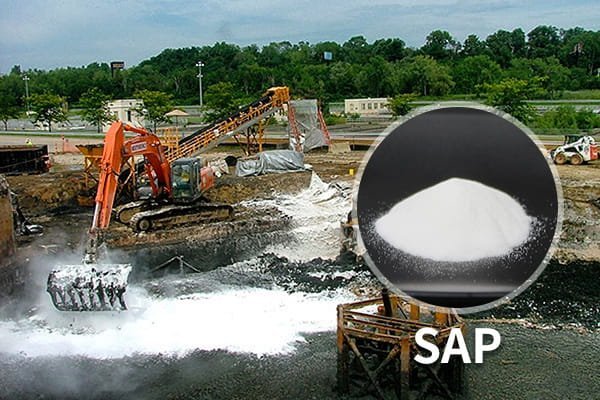Superabsorbent Polymer Water Compatibility in Various Scenes
Superabsorbent polymer (SAP) technology is utilized across a spectrum of industrial, consumer, and professional markets. Many consumers encounter SAPs daily, yet are often unaware of their presence. SAPs are commonly found in applications such as absorbent pads in food packaging, hot/cold gel packs, drilling fluids, and cat litter. Additionally, SAPs are employed to solidify liquids generated during medical procedures, converting them into non-"red bag" waste. Beyond consumer products and medical applications, SAPs are also compatible with a myriad of construction and industrial process waste materials.
SAPs are widely utilized to safely and efficiently solidify a range of waste streams:
- Horizontal Directional Drilling (HDD) Drill Cuttings, Spent Fluid, and Spoils:
SAPs can be mixed with drill cuttings and spent fluids to solidify them, enhancing safety and manageability in disposal.
They also assist in containing and stabilizing spoils produced during HDD operations, thereby mitigating environmental impact.
- Coal Combustion Residuals (Coal Fly Ash and Bottom Ash):
When added to coal fly ash and bottom ash, SAPs bind and solidify these materials, reducing leaching and facilitating disposal handling.
- Wastewater Treatment Sludge and Biosolids:
The integration of SAPs into wastewater treatment sludge and biosolids aids in dewatering, resulting in solid blocks or cakes that are easier to transport and dispose of.
- Water Treatment Sludge (e.g., Alum Sludge):
SAPs can solidify alum sludge and similar water treatment residues, promoting safe handling and disposal.
- Flue Gas Desulphurization Waste:
They are used to solidify and stabilize flue gas desulphurization waste, preventing leaching and enhancing containment.
- Oil and Gas Drilling Fluids and Cuttings:
SAPs effectively solidify oil and gas drilling fluids and cuttings, diminishing their mobility and environmental impact.
When mixed with mine tailings, SAPs form stable, solid blocks that minimize the risk of contamination and erosion.
- Dredged Sediments:
SAPs facilitate the solidification of dredged sediments, reducing water content and improving their stability for disposal or reuse.
- Petroleum Tank Bottom Sludge:
They can solidify petroleum tank bottom sludge, reducing its volume and aiding in safe disposal.
The incorporation of SAPs into retention pond muck solidifies the material, simplifying handling and disposal.
- Saturated or Wet Soil:
Applied to saturated or wet soil, SAPs absorb excess moisture and stabilize the soil, making it more workable.
- Sandblast Media:
SAPs solidify used sandblast media, reducing dust and improving disposal handling.
- Paint Rinsate:
The addition of SAPs to paint rinsate solidifies the liquid waste, simplifying its management and proper disposal.
- Remediation Site Waste:
SAPs assist in solidifying various wastes generated during site remediation, enhancing containment and lessening environmental impact.
- Highway Grinding Waste:
When incorporated into highway grinding waste, SAPs solidify the material, facilitating safer and easier handling and disposal.
- Combined Industrial Liquid Waste Streams:
SAPs solidify and encapsulate combined industrial liquid waste streams, improving containment and promoting proper disposal practices.
Superabsorbent Polymers (SAPs) Essentials:
1. SAPs are distinguished as the swiftest, simplest, safest, and most cost-effective solution for managing liquid waste. They rapidly solidify a broad spectrum of waste fluids, significantly reducing processing time.
No specialized equipment is necessary for utilizing SAPs. Common machinery such as excavators, backhoes, or skid steers can effectively mix SAPs with waste fluids.
2. SAPs are touch-safe, eliminating the need for specific Personal Protective Equipment (PPE), and they prevent hazardous liquid waste contaminants from leaching into landfills and the environment.
With the highest absorbency among available technologies, SAPs can absorb considerable liquid volumes with minimal quantities. Typically, SAPs are applied at dosage rates ranging from 0.5% to 1.5% by weight, a stark contrast to traditional absorbents like sawdust, which may necessitate dosage rates of up to 200%. This low-dosage characteristic is pivotal in reducing transportation and disposal costs, as it directly impacts the weight of the reagents transported and disposed of with the waste.
As a producer specializing in polymer superabsorbent materials, SOCO® offers tailored polymer solutions designed to meet the unique requirements of customers across a variety of applications and environments.



Comments
Post a Comment